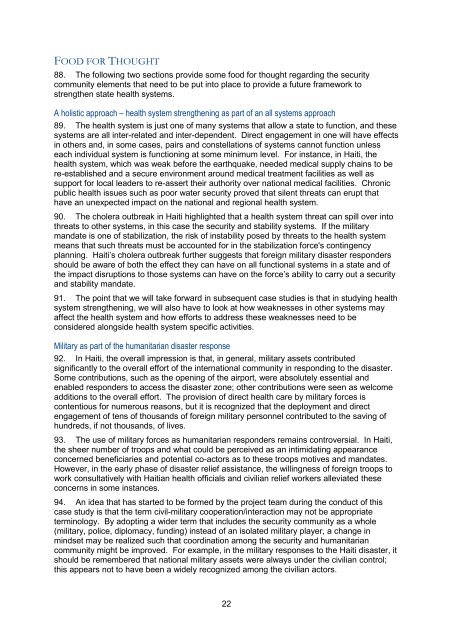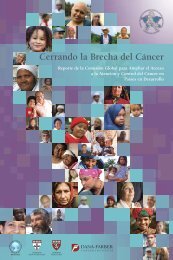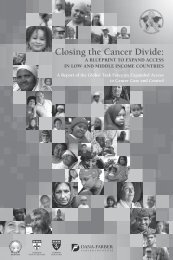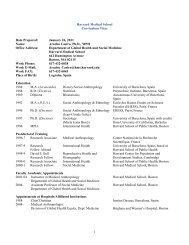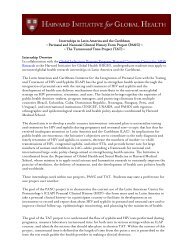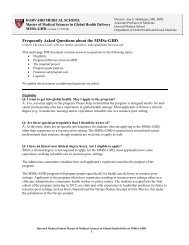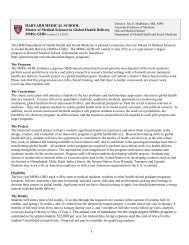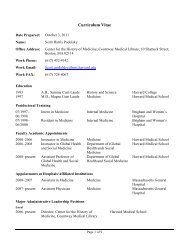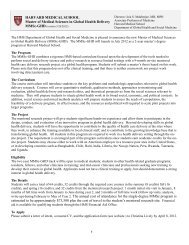Haiti Case Study - The Department of Global Health and Social ...
Haiti Case Study - The Department of Global Health and Social ...
Haiti Case Study - The Department of Global Health and Social ...
Create successful ePaper yourself
Turn your PDF publications into a flip-book with our unique Google optimized e-Paper software.
FOOD FOR THOUGHT<br />
88. <strong>The</strong> following two sections provide some food for thought regarding the security<br />
community elements that need to be put into place to provide a future framework to<br />
strengthen state health systems.<br />
A holistic approach – health system strengthening as part <strong>of</strong> an all systems approach<br />
89. <strong>The</strong> health system is just one <strong>of</strong> many systems that allow a state to function, <strong>and</strong> these<br />
systems are all inter-related <strong>and</strong> inter-dependent. Direct engagement in one will have effects<br />
in others <strong>and</strong>, in some cases, pairs <strong>and</strong> constellations <strong>of</strong> systems cannot function unless<br />
each individual system is functioning at some minimum level. For instance, in <strong>Haiti</strong>, the<br />
health system, which was weak before the earthquake, needed medical supply chains to be<br />
re-established <strong>and</strong> a secure environment around medical treatment facilities as well as<br />
support for local leaders to re-assert their authority over national medical facilities. Chronic<br />
public health issues such as poor water security proved that silent threats can erupt that<br />
have an unexpected impact on the national <strong>and</strong> regional health system.<br />
90. <strong>The</strong> cholera outbreak in <strong>Haiti</strong> highlighted that a health system threat can spill over into<br />
threats to other systems, in this case the security <strong>and</strong> stability systems. If the military<br />
m<strong>and</strong>ate is one <strong>of</strong> stabilization, the risk <strong>of</strong> instability posed by threats to the health system<br />
means that such threats must be accounted for in the stabilization force's contingency<br />
planning. <strong>Haiti</strong>’s cholera outbreak further suggests that foreign military disaster responders<br />
should be aware <strong>of</strong> both the effect they can have on all functional systems in a state <strong>and</strong> <strong>of</strong><br />
the impact disruptions to those systems can have on the force’s ability to carry out a security<br />
<strong>and</strong> stability m<strong>and</strong>ate.<br />
91. <strong>The</strong> point that we will take forward in subsequent case studies is that in studying health<br />
system strengthening, we will also have to look at how weaknesses in other systems may<br />
affect the health system <strong>and</strong> how efforts to address these weaknesses need to be<br />
considered alongside health system specific activities.<br />
Military as part <strong>of</strong> the humanitarian disaster response<br />
92. In <strong>Haiti</strong>, the overall impression is that, in general, military assets contributed<br />
significantly to the overall effort <strong>of</strong> the international community in responding to the disaster.<br />
Some contributions, such as the opening <strong>of</strong> the airport, were absolutely essential <strong>and</strong><br />
enabled responders to access the disaster zone; other contributions were seen as welcome<br />
additions to the overall effort. <strong>The</strong> provision <strong>of</strong> direct health care by military forces is<br />
contentious for numerous reasons, but it is recognized that the deployment <strong>and</strong> direct<br />
engagement <strong>of</strong> tens <strong>of</strong> thous<strong>and</strong>s <strong>of</strong> foreign military personnel contributed to the saving <strong>of</strong><br />
hundreds, if not thous<strong>and</strong>s, <strong>of</strong> lives.<br />
93. <strong>The</strong> use <strong>of</strong> military forces as humanitarian responders remains controversial. In <strong>Haiti</strong>,<br />
the sheer number <strong>of</strong> troops <strong>and</strong> what could be perceived as an intimidating appearance<br />
concerned beneficiaries <strong>and</strong> potential co-actors as to these troops motives <strong>and</strong> m<strong>and</strong>ates.<br />
However, in the early phase <strong>of</strong> disaster relief assistance, the willingness <strong>of</strong> foreign troops to<br />
work consultatively with <strong>Haiti</strong>an health <strong>of</strong>ficials <strong>and</strong> civilian relief workers alleviated these<br />
concerns in some instances.<br />
94. An idea that has started to be formed by the project team during the conduct <strong>of</strong> this<br />
case study is that the term civil-military cooperation/interaction may not be appropriate<br />
terminology. By adopting a wider term that includes the security community as a whole<br />
(military, police, diplomacy, funding) instead <strong>of</strong> an isolated military player, a change in<br />
mindset may be realized such that coordination among the security <strong>and</strong> humanitarian<br />
community might be improved. For example, in the military responses to the <strong>Haiti</strong> disaster, it<br />
should be remembered that national military assets were always under the civilian control;<br />
this appears not to have been a widely recognized among the civilian actors.<br />
22


